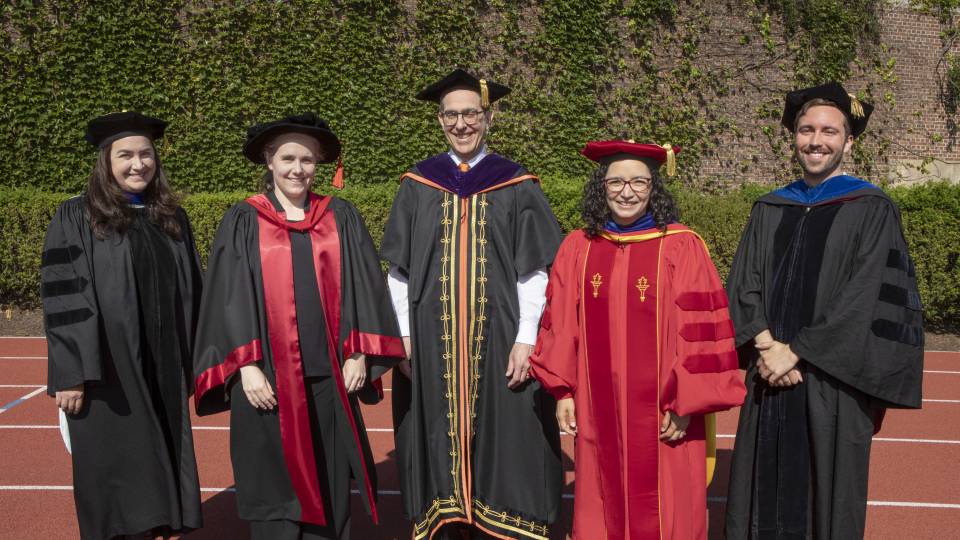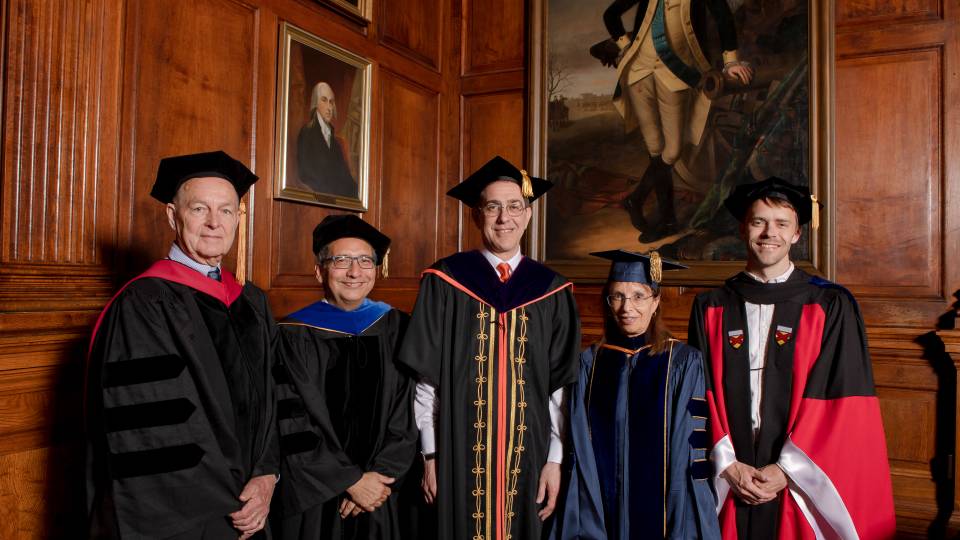Four Princeton University faculty members received President's Awards for Distinguished Teaching at Commencement ceremonies Tuesday, June 5.
They are: Maria Garlock, associate professor of civil and environmental engineering; Carol Greenhouse, professor of anthropology; Daniel Rodgers, the Henry Charles Lea Professor of History; and Jeffrey Schwartz, professor of chemistry.
The awards were established in 1991 through gifts by Princeton alumni Lloyd Cotsen of the Class of 1950 and John Sherrerd of the Class of 1952 to recognize excellence in undergraduate and graduate teaching by Princeton faculty members. Each winner receives a cash prize of $5,000, and his or her department receives $3,000 for the purchase of new books.
A committee of faculty, undergraduate and graduate students, and academic administrators selected the winners from nominations by students, faculty colleagues and alumni.
Garlock, a faculty member since 2003, focuses on research in structural engineering and also directs the interdisciplinary Program in Architecture and Engineering. Her innovative teaching approach and commitment to mentoring have inspired both undergraduate and graduate students. "I admire her insights as a mentor, her enthusiasm as a teacher and her drive as an individual," wrote one graduate student in nominating Garlock for the award. "Education to her is a holistic combination of teaching, research and mentoring."
Garlock's expertise includes the study of structural art, which a colleague noted offers an "educational thrust for students at Princeton, the broader Princeton community and the public." An important example of her activities in this arena was the 2008 Princeton University Art Museum exhibition that she collaborated on with Professor Emeritus David Billington titled "Félix Candela: Engineer, Builder, Structural Artist," which used 19 structural models created by Princeton students under Garlock's guidance. Blending structural art and engineering is at the heart of Garlock's next major project — construction of a 90-foot model of the Golden Gate Bridge, which will be on display near the entrance of the actual bridge in San Francisco in a year's time. Structural art is also central to the course she co-developed, "A Social and Multi-dimensional Exploration of Structures," which debuted in fall 2010 with a focus on the design of tall buildings and required students to build a series of models. The course is designed to feature a new theme each time it is offered.
Colleagues and students agree that Garlock has a remarkable talent for turning what might be viewed as "dry engineering topics" such as "Design for Reinforced Concrete Structures" and turning them into "something irresistible." She has taken the helm in teaching one of the civil and engineering department's most popular courses, "Structures and the Urban Environment." One recent graduate who took the course wrote: "Throughout the lectures, Professor Garlock's passion for engineering was fully evident. I think the track record of this class attracting hundreds of undergraduates from all departments speaks to Professor Garlock's ability as a teacher." Another recent alumnus wrote that he has kept working with Garlock — on the Golden Gate Bridge project — because he "enjoyed his work with her so much he did not want to stop."
As an adviser, Garlock is known for her kindness, patience and ability to explain difficult concepts. One recent graduate wrote that thanks to Garlock's guidance, "My thesis turned out to be the single most rewarding aspect of my time at Princeton." One of her recent Ph.D. students, now herself a professor, wrote, "She has been a constant source of inspiration in my life and an influential mentor." Added another recent graduate alumnus, "It has truly been an honor to be her student."
Greenhouse, who has taught at Princeton since 2001 and has served as chair of the Department of Anthropology since 2007, is a sociocultural anthropologist with primary interests in the ethnography of the law and politics. She has taught seminars on "Ethnography and Democracy in the United States" and on "Social Lives, Social Forces," along with courses on the ethnography of politics and the cultural dimensions of power in states and society. One colleague, who co-taught "The History of Anthropological Theory" with Greenhouse, wrote about the experience: "It was in that class that I was able to watch one of the most brilliant anthropologists teach."
In her courses, Greenhouse often discusses social change, and change is also what her students say happens to them in her classes. One undergraduate, who wrote that she had never been a "huge reader," noted that Greenhouse taught her the "importance of words" — "I read deeper than I ever have before, find meaning in things I never would have before and actually enjoy reading. I attribute this to the genius that is Carol Greenhouse." Another undergraduate cited taking Greenhouse's "Political Anthropology" course as helping her understand relationships of power and how individuals can effect change. "It has inspired me to think more closely about the ways in which I want to produce change and contribute to raising the quality of life in my own community," she explained.
Greenhouse's students say her teaching style is to listen carefully and to create a learning environment where they feel free to express contesting views. One graduate student described her with the words "guide, synthesizer, artist." Another graduate student was grateful for Greenhouse's "Socratic generosity" that gave him confidence to be more adventurous with his work and to express new ideas. "Carol's teaching empowers students to use their freedom to act both on the page and off the page in everyday life. Carol's teaching is courage-giving."
Greenhouse's students as well as her colleagues also commend her dedication as a mentor. One student who was doing thesis research in India for several months relied on Greenhouse's guidance via email and phone calls. "My experience doing anthropological fieldwork was absolutely amazing, and this was in large part because of her encouragement, support and guidance. I would print out her emails, reading and re-reading them. They were brilliant. She is brilliant. And kind." Students on campus cited her accessibility, including "the extent to which she makes herself available for conversation," wrote a graduate student, and "how her active but gentle interest in my life encouraged me to think harder," noted another. "Carol spins her students' intellectual straw into gold but keeps none of the riches for herself," added one colleague. "Utterly unpretentious and personable, Carol's subtle assertiveness is augmented by a gleeful laugh that reverberates through classroom walls and down corridors," noted another.
Rodgers, who has served on the faculty since 1980, is a scholar of American cultural and intellectual history who has taught an array of undergraduate and graduate courses spanning the 19th and 20th centuries. He is also director of the Shelby Cullom Davis Center for Historical Studies. He is a key architect of the current history curriculum for undergraduates and graduate students. "Dan is a teacher-scholar of the first magnitude," said one colleague.
Colleagues credited Rodgers for helping develop the sequence of courses in U.S. history for graduate students. For undergraduates, he took a leading role in establishing junior seminars that helped students as they started work on their junior papers. According to one colleague, this allowed students to be "eased into independent work" and helped them "initiate the dialogue with their advisers that would help them refine their research and writing." Rodgers also created 200-level seminars for sophomores that exposed them to a "sea of documents" so that students learned to develop questions as an integral part of research. These seminars are team-taught by faculty members, "so that potential majors can get a sense that master historians working through the same material can come up with quite different interpretations and insights."
The letters nominating Rodgers for the teaching award came from former graduate students from across the United States and overseas. One wrote, "It's clear that Dan takes very seriously his role as a mentor ... he was beyond generous with his time." Another recalled his "exemplary" role as a dissertation adviser, who to this day is "the person whose opinion I value most highly" and who is the "model of what a historian should be." Another former student who remains in close contact with Rodgers wrote, "Aside from all I learned from him in my coursework, Dan provided me with a model outside of the classroom for how one can successfully be at once a thoughtful writer, a generous member of a scholarly community and a hospitable teacher."
For Princeton history majors, Rodgers is lauded as a dedicated teacher and adviser who helps students do their best work. "Professor Rodgers is totally free of prejudice, free of rigid ideas about How Things Must Be Done," wrote one former student. Added another: "I have known Professor Rodgers as a teacher, an adviser, a mentor and an author. In each role, he has pushed me, through both encouragement and example, to think rigorously about the world and my role within in. What more can one ask of a teacher?"
Schwartz, who has taught at Princeton since 1970, is an organometallic chemist known for his work in reagent development, molecular electronics and cell-surface interactions. One of his current areas of focus is developing coatings that can be applied to medical implants to improve integration with the body. As a researcher and a teacher, he embraces a collaborative approach that is underscored with humor and generosity — "collegial, open, inspiring, brilliant, accessible and fabulous" are some of the words used to describe him.
In the classroom, Schwartz brings technical subjects to life and has inspired many students to study inorganic chemistry and pursue graduate degrees. His innovative approach to teaching the course "Inorganic Chemistry" relies on class participation, the Socratic method and problem sets with examples from the scientific literature. "Rather than insist on memorization of a set of facts — a typical way to teach inorganic chemistry — Jeff makes connections with other chemical concepts that are not typically taught in this course, from organic chemistry to quantum mechanics to kinetics," wrote one colleague. Schwartz also creates handouts rather than relying on textbooks, constantly revising the material to make it fresh. "Instead of fashioning 'toy' problems for us to solve, Professor Schwartz presented us with bona fide literature articles and open challenges in a variety of subdisciplines of chemistry," wrote a student.
Undergraduate students noted that Schwartz is tireless in supporting their development. "I cannot tell you how easy it was as a junior seeking a mentor to feel at home in Jeff's office," noted one student. "Never before had somebody challenged me to think: 'How big is that molecule?'" Another student who met Schwartz as a sophomore recalled a conversation that made him realize that Schwartz "genuinely cared about me and my future, and not only my academic future." He added, "Professor Schwartz is the kind of professor I aspire to be."
Schwartz's mentoring is also important to graduate students as they develop their careers, as well as to seasoned scientists. "His direct involvement with my thesis research gave me the confidence and experience to propose and pursue independent projects in graduate school," wrote one Ph.D. candidate. Another graduate student was grateful for the pragmatism Schwartz exudes in working with the uncertainty of lab experiments. "Every time I run into difficulty in the lab, I now take that as an opportunity to learn something even if it was not what I had originally set out to understand," he noted. And a colleague, who met Schwartz more than 30 years ago, marveled that "Jeff's attention to my growth and professional well-being has not flagged to this day."

